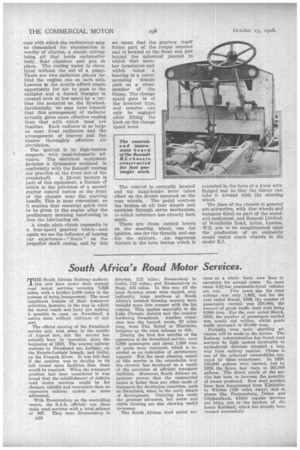South Africa's Road Motor Services.
Page 12

If you've noticed an error in this article please click here to report it so we can fix it.
THE South African Railway authorities now have under their control road motor services covering 7,636 miles, with a further 2,000 miles in the process of being inaugurated. The most significant feature of their transport activities, however, is the way in which the motor coach and lorry are making it possible to open up Swaziland, a native state without railways of any sort.
The official opening of the Swaziland service only took place in the middle of August last, but the service has actually been in operation since the beginning of 1928. The nearest railway stations to Swaziland are Lothair, on the Ermelo-Lothair branch, and Gollel, on the Pongola River. It was felt that if the country was to develop to its full extent more facilities than these would be required. When the transport Problem had been considered it was found that the establishment of definite road motor services would be far cheaper, reliable and convenient than an expensive railway system as sonic advocated.
With Bremersdorp as the controlling centre, the S.A.R. officials ran three main road services with a total mileage of 367. They were Bremersdorp to B28 Breyten, 112 miles ; Bremerdorp to Gollel, 112 miles; and Bremersdorp to Stasi, 143 miles. in this way all the large farming areas were tapped, and, indirectly, large portions of South Africa's isolated farming country were brought more into contact with the big centres. This applies especially to the Lake Chrissie district and the country bordering Swaziland. Another extension was the branch route, 63 miles long, from Piet Retief to Hlatikulu, bringing up the total mileage to 430.
During the first five months of the operation of the Swaziland service, over 5,000 passengers and about 1,600 tons of goods were conveyed, which is regarded as an indication of satisfactory support But the most pleasing aspect of this service is the remarkable way the country has developed as a result of the provision of efficient transport facilities. Moreover, South African experience proves that the commercial motor is better than any other mode cf transport for developing countries, such as Swaziland, when in the early stages of development. Dairying has made the greatest advances, but maize and cattle farming are also showing useful increases.
The .South African road motor Bei. vices as a whole have now been in operation for several years. In most cases 2-2i-ton pneumatic-tyred vehicles are run. Two years 'ago the total mileage was only 1,465, and • for the year ended March, 1926, the number of passengers carried was 258,000, the amount of goods traffic dealt with being 9,900 tons. For the year ended March, 3928, the number of passengers carried was nearly one million, whilst goods traffic increased to 63,000 tons. Probably even more startling advances will be made in the future. The Railway Administration has found road services by light motors invaluable in agricultural districts situated a long way from railway centres. Cream is one of the principal commodities conveyed by these 'motorbuses. In 1926, 135,000 gallons were carried, but by 1928 the figure had risen to 391,000 gallons. The direct result of the service has been to increase the quantity of cream produced. New road services have been inaugurated from Kimberley to Winton (198 miles away) and to places like Postmasburg, Deben and Oliphanthoek, whilst regular services are being run to the borders of the lonely Kalahari, which has already been crossed successfully


































